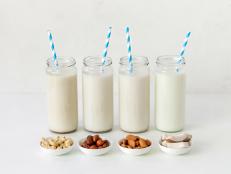All the Non-Dairy Milks on the Market, Reviewed and Ranked
A registered dietitian examines the nutritional benefits of all the plant-based milk options currently available.

4x6/Getty Images
If you’ve wandered down the dairy aisle at your local supermarket recently, or you’ve scrolled through the milk section of your go-to grocery ordering website, chances are you’ve seen a lot of non-dairy beverage offerings. With rice-, banana-, peanut-, and cashew “milks” more readily available now than ever before, you might be wondering which one is the best for you and your family’s dietary needs. Whether you’re actually lactose-intolerance, or you’re just looking for something new to stir into your morning cup of coffee, the following 12 non-dairy beverages each have their own nutritional benefits and best use cases. Our expert tasted each one — keep reading to see what they had to say.
Oat Milk
Oatly is one of the newest oat beverages on the market and was developed in Sweden from research surrounding lactose intolerance. "Researchers were searching for an option that would be a nutritious dairy alternative with good taste and minimal environmental impact," says Sara Fletcher, Communications Lead at Oatly.
Benefits – Starting the day with a bowl of oatmeal isn’t a bad idea, and neither is pouring oat milk beverage into your coffee or cereal. Oatly contains about as much protein (2 grams) and fiber (2 grams dietary and 1 gram soluble fibers) as a half bowl of oatmeal. Unlike many other plant-based milks, it contains two vitamins vegetarians don’t often get enough of: vitamin D (40% of the recommended daily value) and vitamin B12 (50% of the recommended daily value).
Taste – With a viscosity similar to whole dairy milk, Oatly tastes very much like, well, plain oatmeal, only sweeter. One reason is the malt sugar (maltose) organically found in oats. The makers of Oatly use natural enzymes to break down oat starches producing maltose, so Oatly tastes naturally sweet, with 0 grams of added sugar.
Best uses – It doesn’t separate when added to coffee or other hot beverages. The Oatly Barista Edition is thicker than The Original and froths up well; it’s also thick enough to be a good buttermilk stand-in for baking (when lemon juice is added to make ‘sour milk.’)
Make your own – There are several homemade oat milk recipes online, but we really like this smoothie where oats are used as the natural thickener that they are: Healthy Cherry Almond Oatmeal Smoothie.
Almond Milk
Almond milk has been in the refrigerated dairy case and on supermarket shelves in the shelf-stable dairy section longer than many other plant-based milks. Today, several brands are available, so be sure to check the label for a list of ingredients and nutrition facts to find the right one for you.
Benefits – Almond milk is very low in calories and carbs, and can fit into several low-carb diets. Most almond milks are fortified with some vitamins, including 30% of the recommended daily value for calcium and 25% of vitamin E, which is an antioxidant found in almonds.
Taste – Almond milk has a generally thinner consistency. Sweetened versions have a nuttier taste, but in terms of unsweetened nut beverages, almond milk tends to have a more pleasant, almost-sweet flavor than the other beverages, according to our tasters.
Best uses – A nutty taste was hard to detect in a cool cup of Silk Almondmilk, but in baked goods or hot beverages, a slight nuttiness is easier to decipher. In general, almond milk is a fairly blank canvas for making sauces or soups, as long as it’s not heated to boiling. Frozen cubes of it can also be whipped into frosty smoothies.
Make your own – Raw almonds must be soaked overnight to soften and then can be pureed with water to reach the desired consistency. Strain through cheesecloth before drinking and add salt and/or sweetener, if preferred.
Soy Milk
Soy Milk was the first widely available plant-based milk in U.S. stores, appearing in the 1980’s in aseptic packages. Today, it has the highest protein content of any plant-based beverage. While some research on soy protein has been controversial, most scientists agree that the type of soy protein used in soy beverages has several health benefits.
Benefits – Soy beverages are the only plant-based beverage to be included as part of the dairy group in the 2020-2025 Dietary Guidelines for Americans since they are the most similar to milk in nutrient composition. While differences in the types of healthy fatty acids and proteins occur between dairy milk and soy beverages, soy milk does have comparable levels of protein, vitamins A and D, riboflavin and more vitamin B12. Some soy milks have added salt, sugar and gums. Most soy beverages can also carry the health claim that 25 grams of soy protein per day may reduce the risk of heart disease; soy beverages contain 7-8 grams of soy protein per serving.
Taste – Unsweetened versions of soy milk do not appear to be widely available in supermarkets, so our tasters tried the Original Silk version. It had a nutty, sweet “oatmeal-like” flavor. Though its 5 grams of added sugar is lower than most sweetened plant-based beverages, soy milk tends to actually taste sweeter than others.
Best uses – Because of its high protein content, soy milk works better than other vegan milks when replacing dairy milk in baked goods. Acids such as lemon juice or vinegar may be added with soy milk to make buttermilk for pancakes or other quick breads. Soy milk may develop an off flavor if heated over medium or high heat on the stove, but it is generally fine (if not sweeter) when added to hot beverages.
Make your own – Soak dried soybeans overnight, then pulse in a high-speed blender with water and strain through cheesecloth the next day. Next, boil and skim the resulting foam, then cook for an additional 20 minutes at medium heat. Salt and/or sweetener can also be added.
Coconut Milk
This is not the same as coconut milk from a can. Several coconut milks, such as So Delicious Organic Original can be found in your grocery store’s refrigerated dairy case, and Pacific Food’s Unsweetened Organic Original is found with other shelf-stable non-dairy beverages on supermarket shelves in aseptic containers.
Benefits – A serving of So Delicious Organic Original is fortified with 120% of the daily value for vitamin B12, an important nutrient for vegetarians. The beverage is also very low in calories but has zero protein. With a much thinner consistency than canned coconut milk, these paper-carton coconut milks also froth up easier than almost any other plant-based beverage, making for a very frothy latte or steamed milk drink.
Taste – Though coconut milk is surprisingly void of any coconut aromas, the flavor is more pronounced when added to warm beverages and adds a creamy thickness.
Best uses – Because of its ‘frothiness’, coconut milk makes great smoothies. It is also good for baking, but only use it as a replacement for dairy milk, not in place of canned coconut milk.
Make your own – Raw coconut — yes, from a real coconut after you crack it open — can be pureed with water to reach the desired consistency. You can also use shredded unsweetened coconut; just add it with water and seasonings to a high-speed blender and puree. Strain through cheesecloth before using.
Cashew Milk
Our tasters found that cashew beverages made the thickest cup of hot cocoa compared to other plant beverages. It also tasted the thickest when sipped on its own. We tried the popular Silk Creamy Cashew, which is thickened with locust bean gum and gellan gum.
Benefits – The first ingredients are filtered water and cashews, which have a natural creaminess. The Unsweetened version of Silk Creamy Cashew is very low in calories, with 25 per serving, and is fortified with 50% more calcium than dairy milk for a total of 450 mg compared to the 300 mg of calcium found in a serving of cow’s milk. It’s also fortified with 25% of the recommended daily value of vitamin E, which is found naturally in nuts. It has zero cholesterol or saturated fat, but also less than 1 gram of protein. If a gum-free version of cashew milk is preferred, the Forager brand of Cashewmilk Plant-Based Milk Alternative has an ingredient list of only cashews, water, coconut cream, tapioca starch, oats and salt.
Taste – Our tasters noted that the flavor of Silk’s Creamy Cashew was not nutty, but nuttiness was detected in the aftertaste. It didn’t taste dairy-creamy, more “cashew-creamy” as promised. The Forrester brand was more of a blank canvas in terms of flavor and wasn’t especially creamy, as it is just pure nuts and water without additives or thickeners.
Best uses – The Creamy Cashew works well for both warm and cold beverages and makes them very thick. The Forrester brand made a delicious icing and performed very well in baking, especially when used with gluten-free flours.
Make your own – Because they are softer, cashew nuts can be soaked for just a few hours. Next, you puree them with enough water to reach the desired consistency, along with salt and/or sweetener, if preferred. Strain through cheesecloth before drinking.
Rice Milk
With a thin texture and a slightly sweet flavor, rice milk is the most hypoallergenic beverage and can generally be tolerated by people with intolerances to nuts, soy, dairy and gluten. The most popular brand, Rice Dream, is shelf stable and is found on regular grocery stores shelves, not in the refrigerated dairy case.
Benefits – Some of our kid tasters liked this plant-based milk best, so for kids with allergies or intolerances, this is a good choice for hydration or to pop in lunch boxes. The Enriched version of Rice Dream is an excellent source of calcium, vitamin D and vitamin B12. High in carbs (23 grams), it provides energy for active kids. The beverage is a good vehicle for other nutrient-rich foods like pouring on whole-grain cereal or adding to a fruit smoothie, however it is lacking in several important nutrients found in dairy milk, including protein, magnesium, potassium and vitamin A. The beverage contains no gums or thickeners.
Taste – With the added sugar and the faint flavor of the organic brown rice from which it’s made, Rice Dream tastes a bit like rice pudding. The viscosity of the beverage is thin and not especially creamy, so it tastes refreshing when cold.
Best uses – Because the flavor is very faint and the beverage contains very few additives beyond vitamins, salt and a bit of organic expeller pressed oil, rice milk is a good canvas for baking and other recipes. Heat on a low temperature for the best texture when using it to make beverages or soup.
Make your own – Soak brown rice in very hot water for a few hours, then drain and add fresh water along with seasonings to a high-speed blender; puree and strain through cheesecloth.
Hemp Milk
Hemp beverages are made from hemp seeds, which you may have seen in packaged granola. A few varieties are available online and Pacific Foods Hemp Plant-Based Beverage can be found on supermarkets shelves in an aseptic package.
Benefits – Hemp milk has one of the highest amounts of protein per serving with 4 grams (soy milk is higher with 7-8 grams). Hemp beverages contain some omega-3 fats with a healthy ratio of omega-3 to omega-6 fats of about 1:2 or 1:3. Besides soy beverages, hemp beverages are the only plant milks to contain all the essential amino acids. Most brands have at least 15% of the recommended daily value for magnesium, calcium and vitamin D. Hemp milk is helpful for anyone who has an intolerance to nuts, soy or dairy. The hemp plant itself is also known for being sustainable, as it sequesters carbon dioxide and takes little space to grow.
Taste – The lightly sweetened Pacific Foods Hemp Original Milk has a pleasant “cooked grains” flavor, according to our tasters, but is not overly sweet at all. The texture is similar to skim dairy milk.
Best uses – “Hemp beverage works well in smoothies, makes super-fluffy pancakes — like these Dairy-Free Strawberry Sheet Pan Pancakes — and is a nutritious option for adding to cereal and coffee/tea,” says Kari Davis, Pacific Foods Plant-Based Beverage brand manager.
Make your own – Puree hemp seeds and water in a high-powered blender. For more flavor, salt and/or sweetener can also be added.
Macadamia Milk
Macadamia nuts have more fat per serving than almost any other nut, which in theory, would make for a very creamy milk. Luckily, the theory holds true for Milkadamia Macadamia Milk. While there are only 3.5 grams of fat per serving, and the milk is not super thick, it does taste intensely creamy.
Benefits – With only 0.5 grams of saturated fat per serving, Milkadamia’s remaining 3 grams are a combination of healthy monounsaturated and polyunsaturated fats. Most of those polyunsaturated fats are omega-3 fats, which are hard to find in most nuts (besides walnuts). The Milkadamia company also places a big emphasis on regenerative farming, including renewing the soil. It also contains 25% of the recommended daily value for vitamin D and 30% for calcium.
Taste – Unlike many nut milks, macadamia nut milk actually tastes like the nut of its origin, macadamia nuts. The Unsweetened Regular Milkadamia milk has a delicious vanilla aroma and works well in hot drinks.
Best uses – Macadamia Nut milk can be used to replace dairy in almost any recipe.
Make your own – Because they are softer, macadamia nuts need to be soaked for a short time, 1 to 2 hours. Once softened, they can be pureed with enough water to reach the desired consistency, along with salt and/or sweetener, if preferred. Strain through cheesecloth before drinking.
Banana Milk
Created by a veteran of the health food industry, Steven Gelerman, Banana Wave is an innovative way to eat a real banana along with a small amount of sugar, whole grain oats, lots of vitamins and just a little thickener. It might be more accurately labeled “banana juice,” as it doesn’t have any of the creaminess of other non-dairy milks, but it’s also thicker than other plant-based milks, in a smoothie sort of way.
Benefits – A small, whole banana has 360 mg of potassium, while a serving of Banana Wave has that of about half of a banana with 170 mg. After a workout, banana milk wins in terms of hydration, since it has traces of the electrolyte sodium. The drink also contains 60% the recommended daily value of vitamin B12, a nutrient vegans may be missing. Banana Wave contains several of the B vitamins, which help convert food to energy, but in much smaller amounts than dairy milk. The 8-ounce milk boxes could be a fun option for kids who don’t drink dairy milk, since it has less total sugar than most juices (12 grams), but more added sugar (6 grams) than 100% juice.
Taste – Banana Wave is sweet and very refreshing, especially after a workout. It’s sweeter than most drinks, but our tasters didn’t think it was too sweet. The aroma is like a tropical banana paradise.
Best uses – Since it is made from pure bananas, adding a splash or two of Banana Wave to your banana bread or banana muffin recipes is a no-brainer. The brand also tastes delicious when you drink it on its own, pour it over your favorite cereal or add it to your morning smoothie.
Make your own – Blend 1 banana with about 1 cup of water and a tablespoon of oats until you get the consistency of a thin smoothie.
Pecan Milk
While pecans are the only nut indigenous to North America and were important to Native Americans, packaged pecan milk has only been available for only a few years.
Benefits – With more phytonutrients (potent plant protectors), specifically flavonoids, than any other nut, pecans may significantly improve insulin sensitivity and offer protection against cardiometabolic risk factors. Compared to other tree nuts, a serving of pecans, about 19 pecan halves, are among the lowest in carbs (4 grams) and highest in dietary fiber (3 grams) per serving. In each cup of Pure Pecan Milk — the most nationally available pecan milk — there is more than a quarter cup of pecans, slightly less than a full serving of pecans.
Taste – Made from organic Texas pecans, Malk tastes surprisingly like, well, pecans. It is a thinner beverage, but is so good, it would be easy to drink by the cupful.
Best uses – "Pancakes, banana nut bread, smoothies, French toast, lattes, muffins, and cupcakes have all been successfully made by our customers," says Sonia Ortiz, Marketing Director at Malk Organics. "My favorite is a white Russian cocktail."
Make your own – If you can’t find Malk, try making your own. Pecan milk is probably the easiest plant-based milk to make at home because pecans are a softer nut and only require a quick 30-min soak (and straining is optional) in this recipe from American Pecans.
Peanut Milk
In January 2018, a small New York dairy which used to produce only cow's milk and now produces only plant-based milk started making Milked Peanuts.
Benefits – Peanuts have more protein per serving than any other nut; and peanut milk beverage has more protein than any nut milk. The Elmhurst Milked Peanuts brand — which is the most available in grocery stores — contains 6 grams of protein per serving from the 31 peanuts in each glass. It also contains about 6 grams of carbs and 0 grams fiber. "With just five ingredients: filtered water, peanuts, cane sugar, natural flavors and salt, Milked Peanuts represents a ‘clean’ label to most," says Sherry Coleman Collins, registered dietitian at the National Peanut Board.
Taste – If you only eat roasted and salted peanuts, you may be surprised by a more ‘fresh’ peanut taste of Milked Peanuts. But this pure flavor makes peanut milk beverage a perfect canvas for adding it to almost any place you may add dairy milk. And toasty Cheerios seem to be made for swimming in peanut milk, the same is true for chocolatey cereals. The Milked Peanuts with Chocolate is as expected, chocolaty and peanutty.
Best uses – Hot cocoa. It’s naturally frothy and of course, because there are few flavor combos better than chocolate and peanut butter. But because it contains no stabilizers or thickeners, warm it gently in the microwave before adding to coffee, or it may end up looking a bit like miso soup in your cup; or make iced coffee. When warmed slowly for homemade pudding or peanut soup, it does not separate.
Make your own – Can’t find Milked Peanuts? Order it online, or make your own with this recipe from the National Peanut Board.
Pea Milk
Made from yellow pea protein, which help restore the environment, there are a few pea milks available. These include Sproud from Sweden, which can be purchased online, and the more widely available Ripple, which can be found in the dairy case at most regular grocery stores.
Benefits – Vegan, lactose-free, nut-free, soy-free, and gluten-free, a serving of Ripple Pea Milk has the same amount of protein as a serving of dairy milk and 50% more calcium. It also has 32 mg of DHA omega-3 fats, approximately half the amount found in a serving of canned beans. The Unsweetened Original version has 0 grams of sugar. Sproud and Ripple are also focused on sustainability; Sproud uses cardboard packaging, while Ripple uses 100% PCR bottles, which help revitalize farmland.
Taste – Our testers noted that the Ripple Unsweetened Original Pea Milk tasted a bit like a creamy, earthy green tea latte. While they found it to have the creamiest texture among all the other plant-based milks tested, they preferred it cold, as it didn’t seem to taste quite the same when added to hot beverages.
Best uses – Whether you drink it straight from a glass or add it into smoothies or soups, Ripple is pretty enjoyable.
Make your own – Yellow split peas must be cooked first. Then puree them with water and any flavorings and strain through cheesecloth.
It should also be noted that Pecan-, Peanut- and Oat milk beverages may be substituted 1:1 for regular milk in most of your favorite recipes, with the exception of yeast breads; dairy milk makes homemade bread that is richer and more velvet in nature.
Healthy recipes to try with plant-based milk beverages:
Related Links:


































